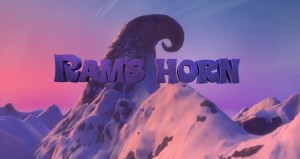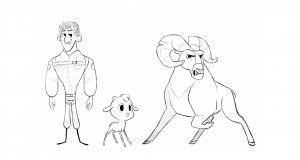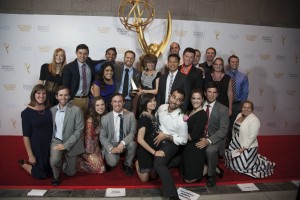
Students from the BYU Center for Animation have brought home another student Emmy from the College Television Awards. The award comes from the same academy that distributes the coveted Emmy award for television.
BYU students gained the award for their work on the 2015 short film “Ram’s Horn.” Students were worried that the film hadn’t made it after weeks of silence from the academy, but that silence was broken April.
“We hadn’t heard back from the Emmys for six weeks since we applied,” animation lead Dallin Cheung said, “When we heard, by that point we had thought we hadn’t made it this year, but we were pleasantly surprised.”
Cheung and the other students working on the film heard the news from producer Garrett Hoyos, who was in direct contact with the academy along with BYU faculty. The academy keeps the faculty and students informed of the film’s progress throughout the decision process.
“That will go through a panel of quite a few judges, at least a hundred,” Cheung said, “They give everything thumbs up or a thumbs down, and the ones that make it through go to the blue ribbon rounds. From those, the student judges choose which films are the best and you get your final three.”
“Ram’s Horn” was one of three films to receive a student Emmy this year, placing third from more than 200 applicants from across the country. The film was completed for submission to the Emmys in January of this year after 13 months of work from students in the project. “Ram’s Horn” started as only a pitch from an incoming senior.

“It all started with a pitch,” Director Jenna Hamzawi said, “Every year, upcoming seniors give a pitch on what their idea for a story would be. The faculty chose the top ten, and then afterwards the seniors vote. We all decided that the best pitch for our year was Ethan Dean’s pitch, which was ‘Ram’s Horn.'”
Students on the project then vote for leadership roles in the project, choosing Hamzawi as director and Hoyos as producer. The film’s production then begins slowly and steadily to a final product and is a “long and arduous process.”
“We start small, with story boards and character designs,” Modeling and Texture artist Landon Price said, “We try to come up with the film in 3D in small scale, with very low detail. From there, we start painting and polishing things. We work on fur, simulations, fire, snow, and throughout the process of an entire year, you get the final result.”
The process of making “Ram’s Horn” took months of development from a wide range of departments. The process completed by students in one year can take even longer for other films.
“There’s one thing about the animation process that people don’t realize, and that is that it is an extremely time-consuming project,” Price said, “Large films can take four or five years to complete.”
The students faced both time and technical barriers throughout the project. Creating “Ram’s Horn” required a wide range of special effects. Hamzawi explained that there were quite a few technical challenges. It was the first time that the team had worked animating snow, and it stretched their abilities.
“It’s ridiculously hard to get snow to look right, and it’s really obvious when it doesn’t,” Hamzawi said. “We had lots of explosions; we had fur on the ram. All those things put together really made a huge challenge.”

Many of the technical challenges required inspiration both visually and thematically to make the quality final project. Students looked at a variety of films and videos to understand how snow appeared and behaved, including snowboarding videos and animated features such as “Frozen” and “Ice Age.”
The biggest inspiration for the film comes from classic cartoons from Chuck Jones. The students viewed cartoons primarily from the classic characters Wile E. Coyote and Bugs Bunny.
“I think the biggest inspiration in terms of motion that we drew from is Wiley Coyote,” Cheung said, “Especially the 3D real effects renditions. We borrowed a lot from that, as well as from the cartoons, to get the sense of timing that we wanted to implement into our film.”




